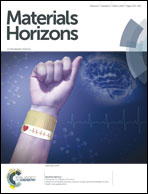Stem cell-compatible eumelanin biointerface fabricated by chemically controlled solid state polymerization†
Abstract
Relying on the water-dependent hybrid conductor properties of eumelanin biopolymers, a structurally controlled melanin thin film that can be reversibly switched-on and off by hydration–dehydration cycles and used as a biocompatible platform for stem cell growth and differentiation up to 11 days is reported. A key feature of the new eumelanin-based bioelectronic interface is its remarkable structural regularity and integrity, as the result of an ad hoc fabrication protocol involving ammonia-induced solid state polymerization (AISSP) technology of a 5,6-dihydroxyindole thin film. The AISSP technology is operationally simple and versatile, enabling the preparation of device-quality thin films (AFM and MALDI-MS evidence) on various substrates with efficient chemical control over molecular complexity. Overall the results of this study pave the way for the implementation of tailored eumelanin thin films for bioelectronic devices, e.g., in organic electrochemical transistors (OECTs).


 Please wait while we load your content...
Please wait while we load your content...